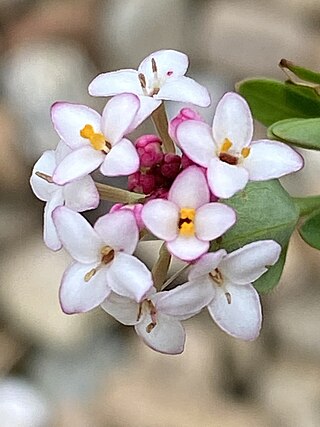
Pimelea spicata, commonly known as the spiked rice flower, is a flowering plant in the family Thymelaeaceae and is endemic to New South Wales. It is a slender plant with white flowers and elliptic leaves.

Pimelea microcephala, commonly known as mallee rice-flower or shrubby rice-flower is a species of flowering plant in the family Thymelaeaceae and is endemic to mainland Australia. It is an erect shrub with compact heads of male or female, white to yellow or greenish flowers on separate plants, the heads surrounded by 2 or 4 leaf-like involucral bracts.

Pimelea humilis, also known as common riceflower or dwarf riceflower, is a species of flowering plant in the family Thymelaeaceae and is endemic to south-eastern Australia. It is an erect or scrambling shrub with hairy stems, elliptic to lance-shaped leaves and heads of 12 to 52 of creamy-white, bisexual or female flowers.

Pimelea octophylla, commonly known as woolly riceflower or downy riceflower, is a species of flowering plant in the family Thymelaeaceae and is endemic to south-eastern continental Australia. It is an erect shrub with densely hairy young stems, narrowly elliptic leaves and heads of 22 to 45 densely hairy, cream-coloured to pale yellow flowers surrounded by 6 to 12 leaf-like involucral bracts.

Pimelea ferruginea, commonly known as pink rice flower or coastal banjine, is a species of flowering plant in the family Thymelaeaceae and is endemic to near-coastal areas of south-western Western Australia. It is a dense, erect shrub with elliptic to narrowly elliptic leaves and head-like clusters of pale to deep pink, tube-shaped flowers.
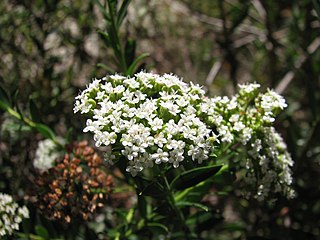
Platysace lanceolata, commonly known as shrubby platysace, is a flowering plant in the family Apiaceae and is endemic to south-eastern Australia. It is small, upright shrub with variable shaped leaves and white flowers.
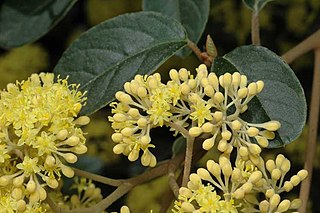
Pomaderris elliptica, commonly known as yellow dogwood or smooth pomaderris, is a species of flowering plant in the family Rhamnaceae and is endemic to south-eastern Australia. It is a shrub with densely hairy branchlets, egg-shaped or elliptic leaves, and pale yellow flowerss.

Pimelea ligustrina is a species of flowering plant in the family Thymelaeaceae, and is endemic to south-eastern Australia. It is a shrub with lance-shaped or narrowly elliptic leaves arranged in opposite pairs, and clusters of creamy-white, white or pinkish flowers usually surrounded by 4 or 8, greenish to reddish brown involucral bracts.

Pimelea drupacea, commonly known as cherry rice-flower, is a species of flowering plant in the family Thymelaeaceae and is endemic to south-eastern Australia. It is a shrub with elliptic leaves arranged in opposite pairs, and head-like clusters of white, tube-shaped flowers surrounded by two or four leaves.
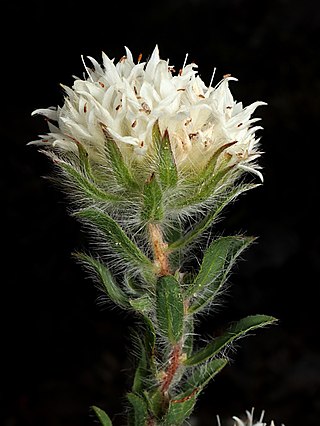
Pimelea imbricata is a species of flowering plant in the family Thymelaeaceae and is native to the southwest of Western Australia and south-eastern South Australia. It is a shrub with narrowly elliptic leaves and erect, compact clusters of white or pink flowers surrounded by 10 to 22 green or red to purple involucral bracts.
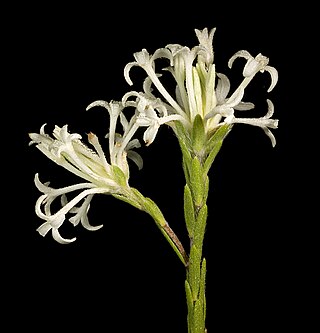
Pimelea longiflora is a species of flowering plant in the family Thymelaeaceae and is endemic to the southwest of Western Australia. It is an erect, spindly shrub with linear to narrowly elliptic leaves and erect clusters of white to cream-coloured flowers, surrounded by 4 to 6 green, egg-shaped involucral bracts.
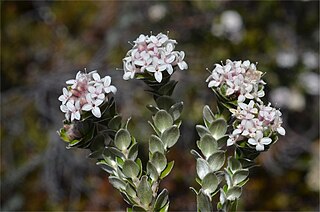
Pimelea sericea is a species of flowering plant in the family Thymelaeaceae and is endemic to Tasmania. It is a shrub with densely hairy young stems, elliptic leaves arranged in opposite pairs, and compact clusters of white, pink or pinkish-white flowers.

Billardiera fusiformis, commonly known as Australian bluebell, is a species of flowering plant in the family Pittosporaceae and is endemic to the south-west of Western Australia. It is a sturdy, shrubby climber that has linear to narrowly elliptic leaves and blue, white or pink, nodding flowers arranged singly or in groups of up to four.

Pimelea curviflora, also known as curved rice-flower, is a shrub in the family Thymelaeaceae and is endemic to Australia. It is a small, hairy shrub with greenish-yellow or red tubular flowers.

Pimelea argentea, commonly known as silvery leaved pimelea, is a species of flowering plant in the family Thymelaeaceae and is endemic to the south-west of Western Australia. It is an erect shrub with densely hairy young stems and leaves, the leaves linear to elliptic, and heads of white to yellow or greenish flowers, the male and female flowers on separate plants.
Pimelea cinerea is a species of flowering plant in the family Thymelaeaceae and is endemic to Tasmania. It is a slender shrub with more or less elliptic leaves, and heads of white flowers surrounded by leaves.
Pimelea clavata is a species of flowering plant in the family Thymelaeaceae and is endemic to near-coastal areas and offshore islands of southern Western Australia. It is an erect shrub with narrowly elliptic to more or less linear leaves arranged in opposite pairs, and head-like clusters of white to pale yellow, tube-shaped flowers surrounded by leaf-like involucral bracts.

Olearia teretifolia is a species of flowering plant in the family Asteraceae and is endemic to south-eastern Australia. It is a bushy shrub with lance-shaped, egg-shaped or elliptic leaves arranged in opposite pairs, and white and yellow, daisy-like inflorescences.
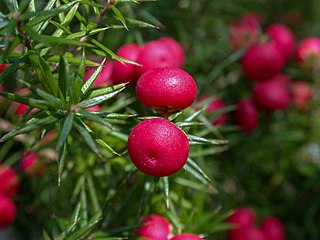
Leptecophylla oxycedrus, commonly referred to as coastal pinkberry or crimson berry, is a medium shrub to large tree native to Tasmania and southern Victoria. It is part of the family Ericaceae and has narrow, pointed leaves, white flowers and pale pink fruits. It was previously classified as a subspecies of Leptecophylla juniperina but has since been raised to the specific level in 2017. The species was originally described in 1805 by Jacques Labillardière in Novae Hollandiae plantarum specimen which was published after his voyage through Oceania.

Leucopogon virgatus, commonly known as common beard-heath, is a species of flowering plant in the heath family Ericaceae and is endemic to south-eastern Australia. It is an erect to low-lying shrub with linear to narrowly lance-shaped or egg-shaped leaves, and erect clusters of three to seven white, tube-shaped flowers on the ends of branches and in upper leaf axils.


















